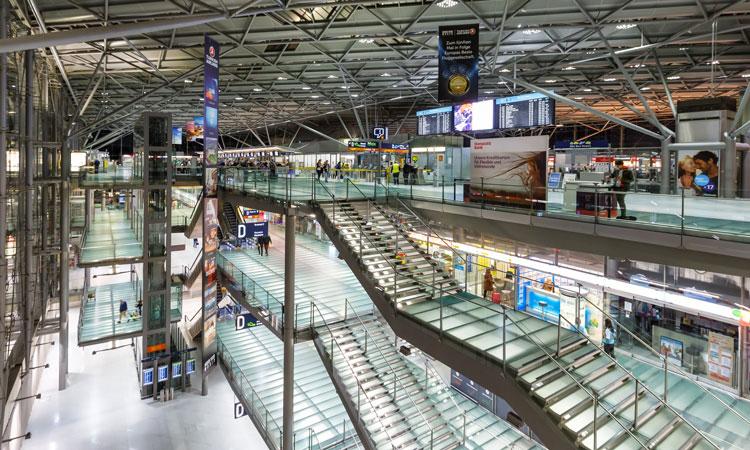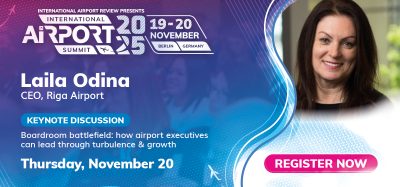Investigating the IT infrastructure at Cologne Bonn Airport
Posted: 3 February 2020 | David Preuss - Cologne Bonn Airport, Tara Nolan (International Airport Review) | No comments yet
David Preuss, Chief Information Officer at Cologne Bonn Airport, provides International Airport Review with an overview of how the use of IT infrastructure is evolving.


Credit: Cologne Bonn Airport
With the broad range of IT applications and technologies available in the aviation industry, every airport’s application differs.
International Airport Review, with its flagship conference focused on airport IT and security, spoke to David Preuss regarding how Cologne Bonn Airport is currently investing in IT infrastructure, as well as his future plans for further implementations.
What is the most efficient technology you have deployed at Cologne Airport?
One particularly efficient technology we have installed at Cologne Airport is a system for passenger flow monitoring and people counting. We have introduced this in our terminals at security controls and check-in areas.
The system helped us broadly, in understanding the passenger flow in our terminals and how we can optimise the route by reorganising the physical locations of available real estate. The system gives a clear indication of the current situation and predictions based on historical data. In that sense we gained a lot of efficiency and are now able to allocate resources early enough to prevent queuing times.
‘Prescriptive’ staff allocation has also become much easier as it is no longer based on varying perceptions of congestion, but on clear measurable insights. We have secured 99 per cent of passengers transferred through security in less than 10 minutes.
How does the implementation of IT systems optimise operations at Cologne – for both passengers and staff?
The implementation of IT systems and infrastructure plays a vital role in enabling the customer journey. This is particularly true for the B2C customer using our facilities and, on the B2B side, the integrator handling shipments in export and import.
Providing easy-to-consume data that can be utilised in the ecosystem up and downstream is important for process efficiency. Baggage claim and its underlying processes, for example, generate quite a large amount of data that can be shared with various parties electronically. The airlines can be provided with timestamps of the first and last bag, which can be communicated to passengers through an airline app. This adds value for the customer, creates transparency and processes information that improvements can be made upon.
Another example is process efficiency, where incoming goods traffic can be streamlined during peak hours through slot reservation of security checks. This improves throughput and helps to increase efficiency through early registration; providing an understanding of incoming goods early on in the process. In that sense, frontloading a process, where we get as much of the necessary data as possible at the beginning of a process, can increase efficiency significantly.
David Preuss will be attending Airport IT & Security 2020, where unique networking opportunities with industry-leading figures are aplenty, alongside panel discussions, debates and product demonstrations.
What challenges stand in between Cologne Airport and implementing further technologies?
Bridging the gap between requirement, nice to have and necessity is sometimes a limiting factor. Not every investment is easy to decide as there are many factors that govern whether the investment will generate enough return. However, some investments are inevitable and need to be done as part of opportunity preparation.
When underlying architectural patterns in IT don’t allow an airport to easily connect with its customers, every addition to your interface collection will not generate revenue but kill it, because maintenance and change management of such unilateral interfaces is a TCO nightmare. It kills flexibility.
Another important issue is how to balance governance and innovation. It is necessary to innovate at a constant speed to keep the environment up to date, at the same time keeping your legacy and niche systems well maintained. Proper application lifecycle management is a key element in sorting out the good, the bad and the ugly.
The last point is definitely the fight for IT resources in the market. The fierce competition for the best people is definitely a challenge.
What are the biggest risks you face when installing new IT systems?
I would like to mention three different categories of risk. Firstly, technical and regulatory risks, second is cultural change risks and third, expectation risks.
Let me start with the last category, which is a tricky one. Considering that information on new technologies today is ubiquitous compared to former times when specific knowledge was only accessible to the experts, it has become harder to explain and consult the business. Sales pitches of solution providers sometimes create the silver-bullet attitude that a specific solution can solve each and every problem.
The second risk I mention is that while moving forward to transform from a sheer infrastructure provider to a data integrator, the cultural change that is necessary will take time. Siloes that exist have to be teared down to create solutions that federate data in a way that it can be beneficial to our customers and thus monetised.
The number one risk is that we have to guarantee with most of our system business continuities at all times. Architectural changes thus need careful consideration of these operational requirements. On top come regulatory requirements for data protection (GDPR mentioned here specifically) which need even more consideration when implementing new systems.


Terminal 2 at Cologne Bonn Airport
Is there a plan to update the IT systems at Cologne? Which technology will you be integrating next, and why this one?
Yes, we will be moving towards a new underlying architecture to connect the plethora of systems that we have. A big role in this endeavour is the switch towards an event-driven architecture that will enable us to federate data with stream processing during its creation. Real-time processing of the different sources of data, and then allowing others to consume an amalgamate of the captured pieces, will be key for success. With such an architectural paradigm, we can generate new revenues because we can more easily share data with ecosystem partners up or downstream.
One key technology we will utilise in this concept will be a stream-processing engine that allows for stream processing, and the publishing and subscribing of mechanisms and persistency. Kafka is one of the most mentioned technologies in this domain. Another key technology that we will utilise for advanced transparency is Elasticsearch in connection with stream processing. The tool will allow us to explore larger amounts of data and build custom dashboards for operations. The benefit of such implementation is that there is no vendor lock-in and we will be flexible to switch to other technologies should we find a better solution.
Join David, and over 100 other airports, at Airport IT & Security in Munich. Over 19-20 October 2020, the top trends in IT and security will be deliberated and discussed.
Looking ahead to the future, what specific technology do you think will be the next disruptor for the aviation industry?
We are already seeing technologies such as AI and smart contracts (Blockchain) enter the scene. I personally think that autonomous vehicles and the broad application of AI will disrupt ground operations. In combination with 5G networks, we will be able to handle use cases where a large amount of telemetry data and low latency is necessary. We can already take timestamps of events using image recognition and machine learning. This will be combined with best practices that already exist for autonomous vehicles in large storage locations and warehouses. Processes that include physical human interactions can then be supported better, and some of the delay factors that we currently witness will be reduced through the smarter integration of humans, technology and algorithms.
Another field of AI application lies in the optimisation algorithms based on data federation. If we are able to federate data like waypoint data, stand capacity, availability of staff, congestion of roads, and waiting time at security checks for cargo, we can make use of learning algorithms and deduct patterns that give us a much better insight on how to steer the flow of goods and passengers.
Biography
David Preuss is currently Chief Information Officer at Cologne Bonn Airport, and has been since September 2019. Previously, Preuss held the position of Lead Business Solution Architect at Schindler Digital Business.
Related topics
Information technology (IT), New technologies, Terminal operations


















